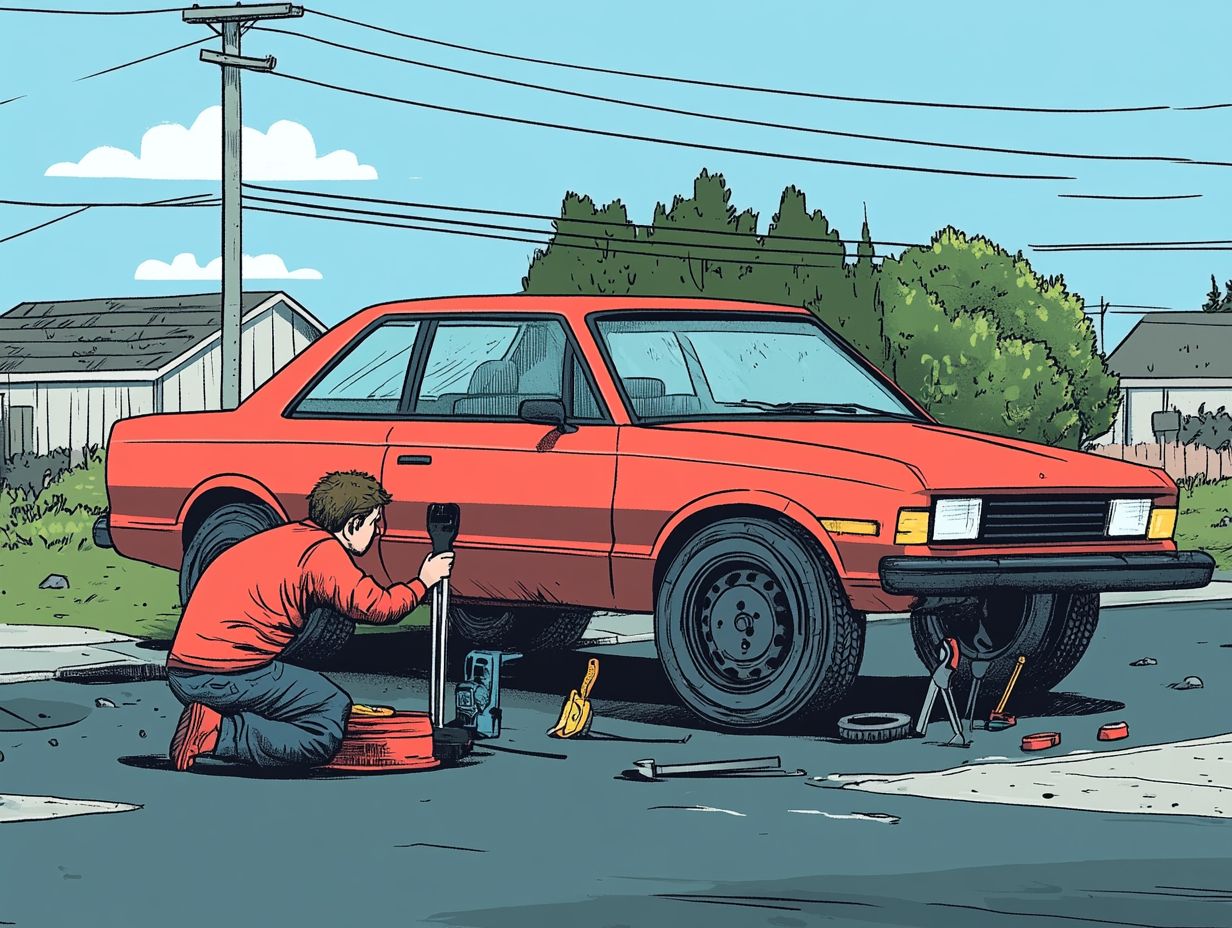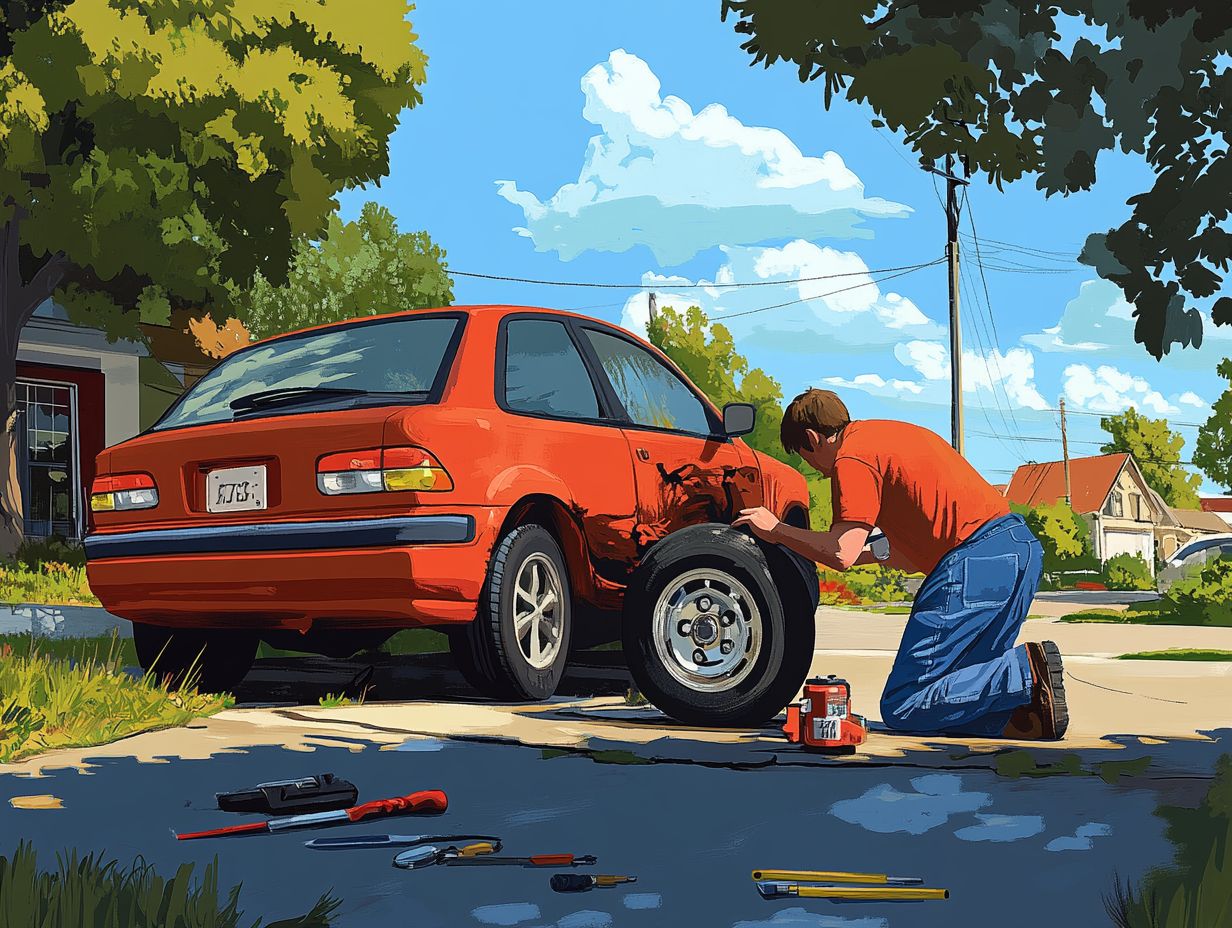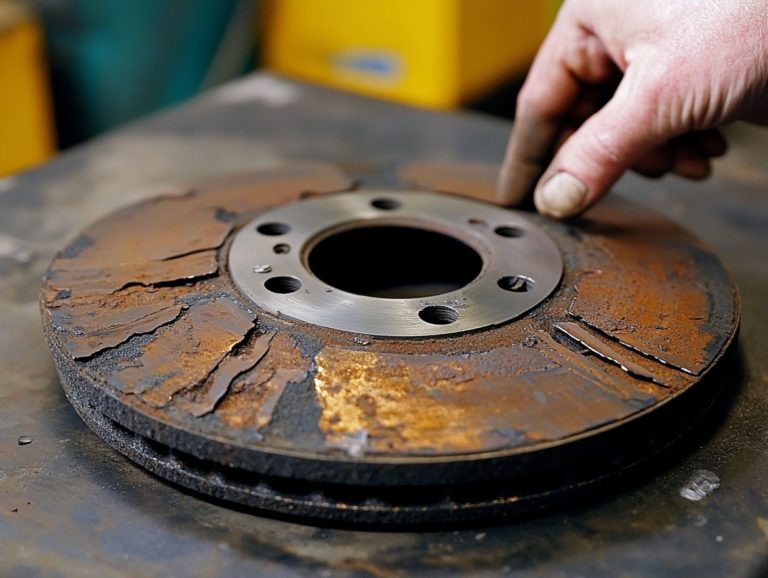What Are the Steps to Take After a Flat Tire?
Getting a flat tire? Don t worry! This guide will get you back on the road in no time!
Experiencing a flat tire can certainly be a frustrating ordeal. Knowing how to navigate it can transform your experience entirely.
This guide provides you with essential steps to assess the issue, identify the cause, and check for any damage. You ll discover the tools necessary for changing that tire efficiently and effectively.
With clear instructions at your fingertips, you ll gain the confidence to tackle a flat tire head-on. You will also find valuable tips for prevention and guidance on what to do if you find yourself without a spare. Prepare yourself to hit the road again with ease!
Contents
- Key Takeaways:
- Assessing the Situation
- Tools and Materials Needed
- Step-by-Step: Changing a Flat Tire
- Tips for Preventing and Handling Flat Tires
- Frequently Asked Questions
- What Are the Steps to Take After a Flat Tire?
- Is it safe to continue driving on a flat tire?
- What is the first thing I should do when I realize I have a flat tire?
- Should I call a tow truck if I have a flat tire?
- Can I drive on a spare tire for an extended period of time?
- What should I do if I do not have a spare tire?
Key Takeaways:

- Assess the situation to know your next steps!
- Make sure to have all the necessary tools and materials on hand for changing a flat tire.
- Follow a step-by-step guide to changing a flat tire, including preparing the vehicle, loosening lug nuts, jacking up the vehicle, removing and installing the tire, and finishing up.
Assessing the Situation
When you face a flat tire, assessing the situation is essential for your safety. Pull over to a secure location and activate your hazard lights.
Consult your vehicle owner s manual to familiarize yourself with the recommended procedures. Taking a moment to evaluate the circumstances surrounding the flat tire will enable you to determine the most prudent course of action.
This may mean calling roadside assistance or tackling the tire change yourself. Always prioritize safety to prevent any potential accidents on the road.
Identifying the Cause of the Flat Tire
Identifying the cause of a flat tire is crucial for maintaining your vehicle and ensuring your safety on the road. Common culprits often include punctures from sharp objects or slow leaks caused by damage to the part that lets air in and out of the tire.
Worn-down tire treads and improper tire pressure can lead to premature wear or even blowouts. So, it s vital to check your tire inflation regularly.
Consistent maintenance not only extends the lifespan of your tires but also significantly boosts your driving safety. When faced with a flat, utilizing a tire repair kit can offer a quick and efficient fix.
This allows you to get back on the road safely until you can arrange for a more permanent solution.
Determining the Extent of Damage
Determining the extent of damage after encountering a flat tire is crucial in deciding whether you can handle the change yourself or if it’s time to call in a tire technician.
Begin with a thorough visual inspection of the tire. Look for any obvious punctures, such as nails or sharp objects lodged in the tread, and check for bulges or tears that could signal sidewall damage.
Pay close attention to the tread depth if it s uneven or excessively worn, your safety might be at risk. Also, assess whether the tire is losing air quickly or slowly; a rapid deflation often points to a more serious issue.
If you find significant damage or multiple punctures, it’s wise to consult a professional at a service station to ensure the tire can be repaired safely. Regular evaluations are essential; they not only help maintain optimal performance but also extend the life of your tires.
Tools and Materials Needed
Equipping yourself with the right tools and materials is crucial for efficiently changing a flat tire. This allows you to tackle the task with poise and minimal stress.
Essential items include:
- A sturdy lug wrench for loosening those stubborn lug nuts,
- A reliable jack for safely raising your vehicle,
- A spare tire poised to replace the flat.
You might also consider having a tire repair kit on hand for quick fixes to minor damages, enabling you to get back on the road promptly. Being well-prepared with these tools not only saves you precious time but also bolsters your confidence in managing tire-related challenges.
Now that you’re prepared, practice changing a tire in a safe environment!
Essential Items for Changing a Flat Tire
When you’re gearing up to change a flat tire, having important items on hand is crucial for a seamless and safe experience.
- First, a lug wrench is your best friend; it s necessary for loosening and tightening the nuts that hold the tire in place, making it a cornerstone of any tire-changing kit.
- Next, you need a jack it s vital for lifting the vehicle, giving you access to that pesky flat tire.
- Don t forget about the spare tire; it s your ticket to getting back on the road without missing a beat.
Wheel wedges are important too; they prevent the vehicle from rolling, adding an extra layer of safety. And let s not overlook the parking brake engaging it is essential for stability, ensuring that everything stays put during the tire-changing process.
With these tools at your disposal, you’ll be ready to tackle a flat tire like a pro!
Step-by-Step: Changing a Flat Tire

Changing a flat tire involves a series of important steps that, when executed properly, can guarantee your safety and ensure the task is accomplished effectively.
Begin by positioning your vehicle on a level surface. Engage the parking brake and place wheel wedges for added security. Once you ve done that, gather the necessary tools and prepare for the tire change.
Each phase loosening the lug nuts, raising the vehicle, and carefully mounting the spare tire demands precision and attention to detail to avert accidents or additional damage to your vehicle.
1. Preparing the Vehicle
Preparing your vehicle is one of the most important steps before changing a flat tire. This ensures both your safety and efficiency.
- First, find a flat, stable surface away from traffic where you can securely park your vehicle.
- Once you’ve pinpointed the location, apply the parking brake firmly to prevent any unintended movement.
- Next, activate your hazard lights; this alerts other drivers to your situation and enhances your visibility.
- Place wheel wedges against the tires that remain on the ground to secure the vehicle and prevent any rolling.
These actions are fundamental for minimizing risks while you tackle that flat tire.
2. Loosening the Lug Nuts
Loosening the lug nuts is crucial when preparing to change a flat tire, as it lays the groundwork for a safe and efficient process.
Ensure that your vehicle is parked on a flat surface and that the parking brake is engaged. Once sorted, locate the hubcap and gently pry it off using a flat tool, taking care not to damage the wheel.
With the hubcap out of the way, grab your lug wrench typically designed with a cross-pattern for extra leverage and fit it snugly over a lug nut. To break the initial grip, use a quick jerking motion. This is particularly effective for stubborn nuts.
Remember to turn the wrench counterclockwise and apply consistent pressure while standing clear of the tire for safety.
3. Jacking up the Vehicle
Jacking up your vehicle properly is crucial when changing a flat tire; it ensures your safety and stability as you work.
- Start by finding a level surface to park your vehicle; this significantly reduces the risk of it rolling away.
- Once your vehicle is securely positioned, locate the designated jacking point, which is typically detailed in the owner’s manual.
- With the jack in position, tighten the handle securely before gradually raising the vehicle until the flat tire can be removed easily.
- Throughout this process, keep one hand on the jack for control and wear safety gloves to protect yourself from any sharp edges.
Using wheel chocks can also prevent unwanted movement, further enhancing your safety during the tire change.
4. Removing the Flat Tire
Removing a flat tire is an important job that demands careful attention to detail and safety.
Once your vehicle is securely elevated on a jack, the next step is to loosen the bolts used to secure the tire. Use a lug wrench and apply steady pressure as you turn them counterclockwise.
- Start with the bolt opposite the first one to ensure an even distribution of force.
- Be careful not to apply excessive force, as that could strip the bolts and make them difficult to remove later.
Once all the bolts are loosened, you can easily remove them by hand. Handle them with care and place them in a secure spot to avoid misplacing any during the tire change.
5. Installing the Spare Tire
Installing the spare tire correctly is essential to ensure your vehicle operates safely until you can get that flat tire repaired.
As you prepare to mount the spare tire, having a clear, step-by-step guide handy will enhance safety and efficiency throughout the process.
- Start by finding a safe, flat surface to park your vehicle, then secure it with wheel chocks or engage the parking brake.
- Next, remove any hubcaps if necessary, and loosen the bolts slightly before lifting the vehicle with a jack.
- Once the spare tire is in place, tighten the bolts properly.
- Follow a star pattern to create even pressure and prevent any wobbling.
- After securing the spare, check the tire pressure. Properly inflated tires are crucial for maintaining control and avoiding issues while driving.
Diligently completing these steps will ensure a smoother, safer ride.
6. Tightening the Lug Nuts

Tightening the bolts after installing your spare tire is a crucial final step that directly influences your vehicle’s safety and performance.
Ensuring each bolt is properly secured prevents future headaches and guarantees that your spare tire stays firmly in place while you drive. Use a star pattern to evenly distribute pressure across the wheel, reducing the risk of warping or uneven wear.
Apply the correct how tightly to screw on the nuts as outlined by your vehicle s manufacturer, enhancing the longevity of both the tire and the wheel. By prioritizing this step, you significantly contribute to your overall driving stability and safety, minimizing the chances of accidents due to improper tire attachment.
7. Lowering the Vehicle and Finishing Up
Lowering the vehicle safely and properly stowing away all equipment signifies the successful conclusion of your tire-changing endeavor.
To start, gently lift the jack handle and lower the vehicle until it settles securely on the ground. Be meticulous ensure that no tools or equipment are left lying around, as this could create an unnecessary hazard. Each tool should find its way back to its designated storage space; this keeps everything organized and ensures nothing is overlooked.
Afterward, don t forget to check the tire pressure of the spare tire! This final precaution confirms that it s adequately inflated and primed for any future emergencies. Remember, maintaining all tires, including your spare, is crucial for your overall vehicle safety.
Tips for Preventing and Handling Flat Tires
Preventing and managing flat tires effectively requires a keen understanding of the significance of proper tire maintenance and heightened awareness while driving. By conducting regular inspections, ensuring your tire pressure is spot on, and remaining vigilant about road conditions, you can significantly diminish the chances of encountering a flat tire.
Being equipped with the knowledge of how to handle a flat tire when it arises allows you to respond swiftly and safely, ultimately elevating your overall driving experience.
Proper Tire Maintenance and Inspection
Proper tire maintenance and inspection are essential for extending tire life and ensuring your driving experience is as safe as possible.
Regular pressure checks should be a regular part of your routine. Maintaining optimal tire pressure not only boosts fuel efficiency but also enhances your vehicle’s handling.
Keep an eye out for signs of wear and tear things like uneven tread patterns or sidewall damage. Addressing these issues early can help you avoid more significant problems in the future.
If you notice serious wear or feel uncertain about a tire s condition, consult a tire technician. Their expertise can offer invaluable insights regarding necessary repairs or replacements, ultimately protecting both you and your vehicle on the road.
What to Do If You Don’t Have a Spare Tire
If you find yourself with a flat tire and no spare, don t panic! There are quick steps you can take to get back on the road.
One option is to consider using a tire repair kit, which can provide a temporary fix to get you back on the road. These kits often come equipped with sealants and inflators, making it easier to tackle minor punctures without too much hassle.
If the damage is more severe, reach out to a roadside assistance service, a service that helps drivers with issues on the road. They can either tow your vehicle or help with repairs right on the spot.
It’s also essential to understand what your vehicle insurance covers in these scenarios. Certain policies might include roadside assistance costs, making the entire process smoother and considerably less stressful.
Frequently Asked Questions
What Are the Steps to Take After a Flat Tire?

If you experience a flat tire while driving, follow these steps to safely and efficiently handle the situation.
Is it safe to continue driving on a flat tire?
No, it is not safe to drive on a flat tire. Continuing to drive can cause damage to your vehicle and potentially lead to an accident.
What is the first thing I should do when I realize I have a flat tire?
When you realize you have a flat tire, the first thing to do is safely pull over to the side of the road and turn on your hazard lights.
Should I call a tow truck if I have a flat tire?
If you know how to change a flat tire and have the necessary tools, you can change it yourself. However, if you do not feel comfortable or are unable to change the tire, it is safer to call a tow truck for assistance.
Can I drive on a spare tire for an extended period of time?
A spare tire is only meant to be a temporary solution. It should not be driven on for an extended period; get the original tire repaired or replaced as soon as possible.
What should I do if I do not have a spare tire?
If you do not have a spare tire, call for roadside assistance or a tow truck to have your vehicle towed to a nearby mechanic or tire shop for repair or replacement.
Remember to check your tires regularly and consult a professional for routine maintenance to ensure safety on the road.






